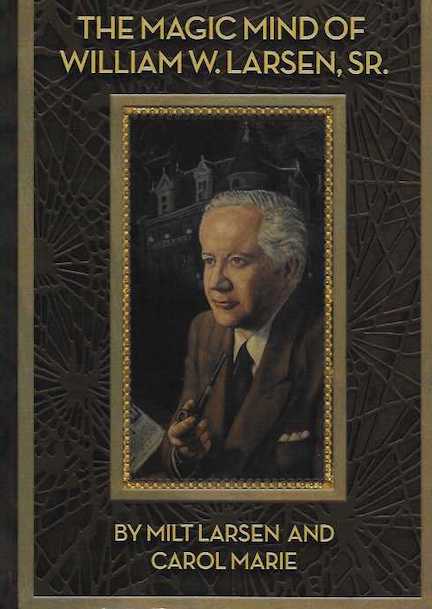
IN THE BEGINNING --Milt Larsen’s father, William W. Larsen, Sr., was the patriarch of a magic dynasty, indeed of the dynasty that has most enriched my own life in magic. Given my long awareness of all things Larsen, I found Milt’s new book, The Magic Mind of Willam W. Larsen, Sr., all the more special.Written and compiled by Milt and Carol Marie, the book is a grand assembly of memories and manuscripts, much of the text in the direct voice of the original Mr. Larsen. Milt shared only 22 years with his father but has so far devoted 91 years to honoring his influence. The new volume is a fine addition to that tribute.
Part I contains Magically An Idea or Two, Mr. Larsen’s first booklet. Published in 1932 in a limited edition of 100, it displays the diversity of the aauthor’s interests, with pocket and parlor scale apparatus magic, card tricks from the likes of T. Page Wright, William McCaffrey, and Charlie Miller, and A Young Man’s Fancy, an illusion in which a stenographer vanishes, having magically eloped with a businessman!
Part II covers the biographical essentials. Son of the founder of a Green Bay pea packing company, in Wisconsin, William Larsen moved to California to practice criminal law (missing out on a career in football?), where he met and married Geraldine Conrad and started a family. Early visitors to Pasadena included the likes of Cardini, Malini, and Leipzig. Mr. Larsen later took a ten-year hiatus from law to tour a family magic show (the show is described trick by trick in this book), making good money even during the depression. Young Milt and brother Bill dressed as bellboys in the act, proving to be more handy tan side tables for dealing with props. The boys had a star turn in the show themselves with The Mismade Flag.
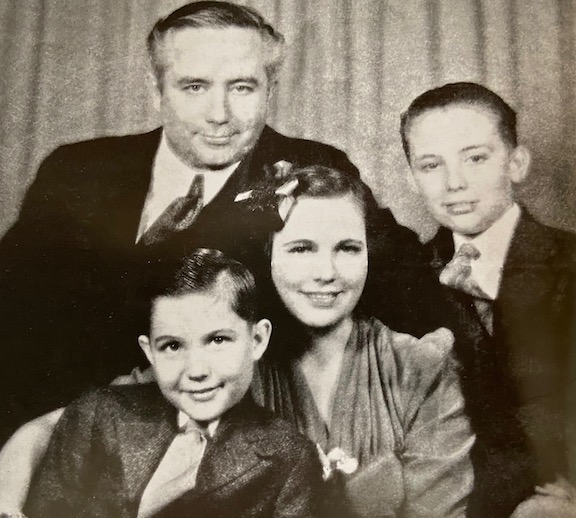
In his teens Bill Larsen contributed often to The Sphinx with his partner T. Page Wright, and in 1936 launched Genii magazine. In 1942, the Larsens bought the Thayer Studio of Magic and swapped houses with Thayer, moving themselves from Pasadena into the home in Los Angeles that would be called Brookledge. As a result Milt and Bill continued to grow up in what seemed an ongoing magic convention. One of Milt’s favorite moments was hiding in the bathroom and being the voice of a Haunted Teakettle.
Through Genii, William W. Larsen became an opinionated force in magic. Continuing the Thayer publishing, he wrote many manuscripts and sold them through Genii. He would advertise the idea, and if there was interest he would go ahead and write it, usually in one sitting. Occasionally he would ask Milt if he had any ideas to contribute. One such manuscript, "50 Workshop Ideas,"" is included in this section.
And for Part III, “Camp Shows.” Milt was almost 11 on December 7, 1941, when so much of life changed. By 1943, after considerable military performances, Mr. Larsen wrote a remarkable manuscript titled “Camp Show Conjuring,” reproduced entirely here. Although the detailed advice was on how to entertain the troops, it is excellent advice for any magical performer. It struck me as being all too real, and it gives a marvelous look at the world of magic during that time, of who was performing what, and where.
Part IV, “Television Magic,” celebrates Milt’s mom in magical history. Geraldine Larsen was the first magician televised (for GE at the 1939 World’ Fair) and would go on to be the first with her own televised program, “The Magic Lady,” in Los Angeles. Manuscripts in this section include “Tricks for Television,” “12 Illusionettes,” and “Quintet of Illusions.” The illusions were “easy to build” and delightfully illustrated by Eugene Poinc, who would still be drawing for Genii when I began subscribing in 1959.
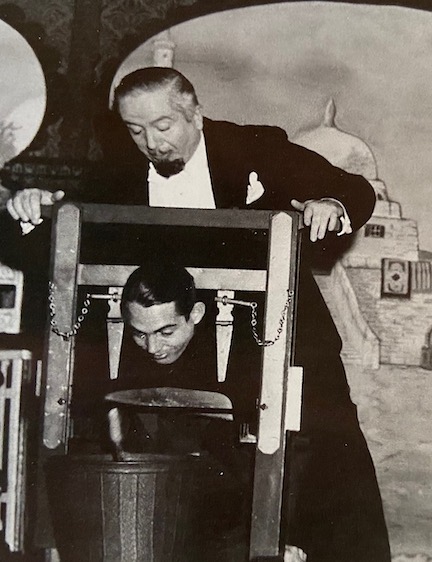
Part V, “Spook Shows,” addresses my favorite topic. As teenagers, Milt and his writing buddy Harrison “Red” Baker worked for Ormond McGill aka Dr. Zomb, many late nights. The section concludes with my all-time favorite of the Larsen manuscripts, “A Spook Show in Your Parlor.” Wasn’t that advertised in comic books? Here are a dozen wacky scary ideas involving such paraphernalia as Lycopodium powder and a cage of two or three live rats “or, if you prefer, thin black guinea pigs.” I’ve been wanting to put on this show all my life.
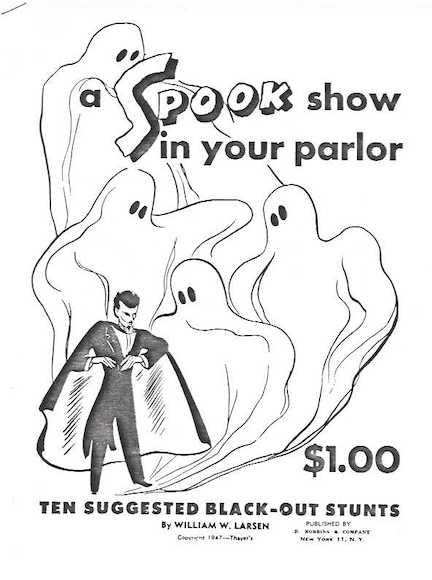
Part VI, “Radio and Nite-Club Mindreading,” is the longest section in the book, and the most dated, but I mean that in a good sense. It provides an highly detailed view of mentalism of that era, especially Q and A. This chapter would have served as excellent source material for the recent del Toro movie version of Nightmare Alley.
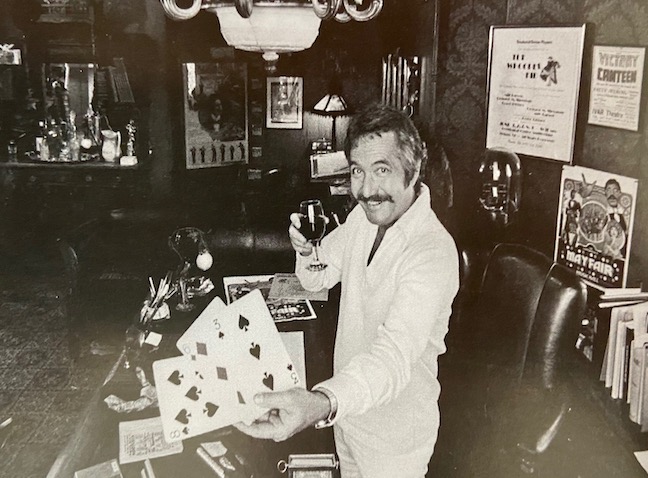
Part VII, “Children’s Magic,” draws on the family’s experiences in Larsen’s Conjuring for Children” and “Puppetrix.” I applaud any children’s magic books that contains the obvious advice, “Don’t play down to them.”
Part VIII, “Patter Presentation Ideas” contains two Larsen manuscripts. “Patter Plot Script” gives plots (not word-for-word patter) for standard parlor tricks as Cut and Restored Rope, Linking Rings, and Blue Phantom. And “How to Routine Magic Shows” is just that, a comprehensive primer on this important topic.
Part IX “Dad’s Favorites” notes that Milt and Bill could later perform their dad’s tricks using his exact patter. I am especially fond of the first two items in this section. “The Magician’s Hobby” is a hilarious analysis of the poem “Old Mother Hubbard”while illustrating with a Die Box. Does that make sense? I am reminded of the 1950s’ recording It's in the Book. The second is my favorite Larsen creation, Fatima. I have performed Fatima, the true dancing handkerchief, in most every kid show I have done, but it also plays for adults. I learned it from Genii. I understand that Max Maven has performed it (love to see that), and I can picture Zabrecky doing it. Just a great routine.
In Part X, “Bill Larsen Trickeries,” Milt mentions his dad’s return to law, his friendship with Judge Fricke who also attended the Final Houdini Seance, a couple of times his dad used magic in the courtroom, and his dad’s hope for a magical clubhouse and the founding of the Academy of Magical Arts and Sciences through the pages of Genii. Oh, how time would tell.
In the book Milt mentions that The Mental Mysteries and Other Writings of William W. Larsen, Sr. was intended as the first in a trilogy.One might consider the present volume to be a second, and a third book is in preparation, containing William Larsen’s writings in The Sphinx and Genii.
The current book is available both hard cover ($40) and soft ($25), 264 pages, written and compiled by Milton Page Larsen and Carol Marie, handsomely produced in the manner of recent Milt Larsen titles. I am thrilled to have my copy signed by both authors. Look for it in the Magic Castle gift shop.
Previously cited Milt Larsen titles:
Magic Castle: Beyond the Smoke and Mirrors by Carol Marie June 2017
My Magical Journey by Milt Larsen. December 2012
The 60th Anniversary: It's Magic! by Milt Larsen with Steve Bryant and Carol Marie. October 2016
Magic Castle ... The Inside Story by Milt Larsen. October 2002
Hollywood Illusion: Magic Castle by Milt Larsen December 2000
Hockman, the Great, Exposes Himself! by Milt Larsen. January 1999
Milt Larsen's Magical Mystery Tour of Hollywood's Most Amazing Landmark: The Magic Castle by Carol Marie. February 1998
(Note that, even when not the writer or co-writer, Carol Marie was usually the editor. Kudos for beautiful work.)

SHOCK THEATER —- There were three catalysts in a five-year period that positioned the Abbott’s Magic Company to capitalize on a surge of ghost show and seance performers. First, Houdini died on October 31, 1926. Could he return? Seances would convene to provide the answer. Second, El-Wyn created the first midnight spook show in 1929. Unlike Houdini, he kept his secrets and frightened his young audiences. And tthird in 1931, the demand for spooky entertainment was fueled by the movies Dracula and Frankenstein.
Percy Abbott opened his magic shop in 1934 and immediately began selling to the midnight spook show crowd, not only with individual effects but with a complete 60-minute Ghost Show. Abbott referred to the magicians, mediums, hypnotists, mentalists, and psychics who bought from him as midnight performers, and advertising to reach them as TARGET: MIDNIGHT.
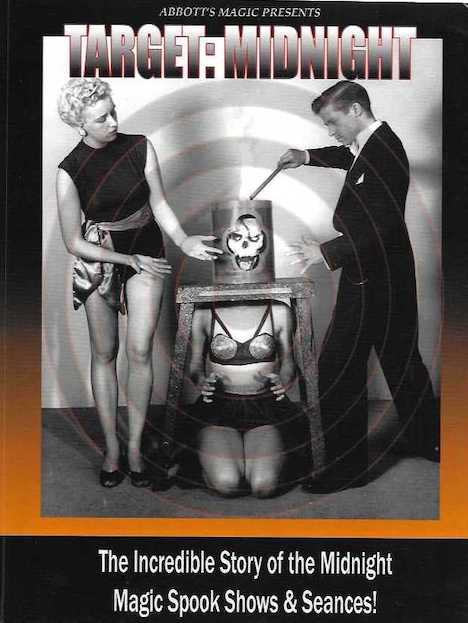
TARGET: MIDNIGHT is also the name of a whopping new ghost show book from Abbott’s, released at the 2022 Abbott Get Together. This is a massive compilation, some 572 pages with small, dense txt. It reminds me of a large city telephone book or a full Sears catalog, for those who remember such things. Abbott’s has been selling to and chronicling ghost shows since 1934, mostly in the pages of TOPS and THE NEW TOPS, and you will find nearly every word of that story in these pages. (It is similar in format, layout, and theme to Dark Matter Secrets, published by Abbott’s in 2014.)
The book leads off with the Ormond McGill Files, a dozen on Psychic Development and four more on Psychic Circle. These seem written for shut eyes. (16 files in 36 pages)
Next the Walter Hudson Files, a dozen under the heading “Magic & Mayhem at Midnight” and a dozen more under “Magical Whirligig.” (24 files in 52 pages) Note that Hudson inspired a young Mark Walker to write his excellent books on ghost shows.
Then “Target: Midnight Performer Articles” such as “Percy Abbott on Lester Lake,” “Dorny on Bill Neff,” or “Senator Crandall on Bill Neff Remembered.” (32 articles in 49 pages)
Followed by Target: Midnight Feature Articles,” such as “Eddie Joseph on Spirit Cabinets,” “Eddie Clever on Seance Shadows,” or “Tony Shiels on Phantasmagoria.” (34 articles in 70 pages) The article “1994 Spook Show Quiz by Tops Magazine” is a fun test of your ghost show knowledge. And the six-page “Planning John Calvert’s 100th Birthday Party by Hnk Moorehouse” features photos by my friend David Linsell. Nice!
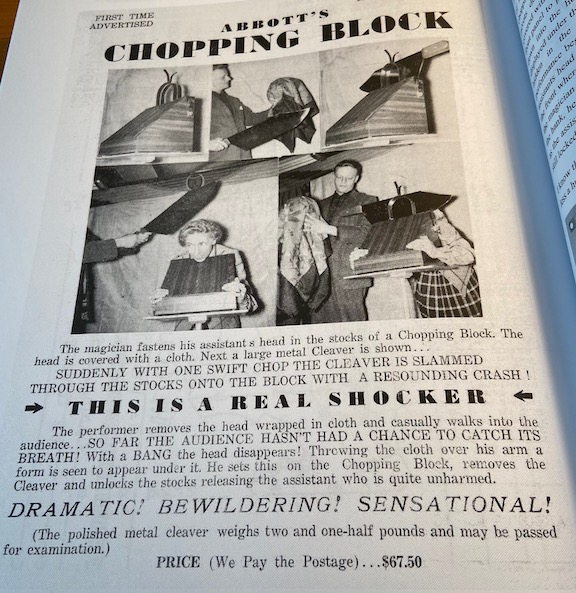
“Target: Midnight Through the Spookvine”supplies a year by year mention of every time a ghost show or ghost show worker made the news, from 1936 to 1994, plus one more entry for 2022. Most interesting. You can follow the rise and fall of the ghost show era on your own. There are up to ten entries per page, and ghost show advertising posters decorate the news. (330 entries in 49 pages)
Believe in “Target: Midnight Houdini Seances Files” with such pieces as “Houdini Seance Create Your Own by John Novak,” “Houdini Seance Television Special by Walt Hudson,” and the funny “Houdini Seance Vent Act by Bob Asa.” (20 articles in 25 pages)
Those who wish to construct and perform their own ghost show material will enjoy the section “Target: Midnight Magic,” with illustrated instructions including complete Abbott’s Workshop Plans. The material is broken into five eras: “Target: Midnight El-Wyn Style Seance Effects,” “Target: Midnight Silkini Era Magic,” “Target: Midnight Bill Neff Era Magic,” “Target: Midnight Ray-Mond Era Magic,” and “Target: Midnight Dr. Evil Era Magic.” You will find complete plans for an Asrah and and Aga Levitation, plus five pages devoted to Super-X, including a two-hoop handling. I have long coveted Abbott’s Chopping Block and was pleased to see photographic evidence of its method. And many will enjoy the seven pages devoted to the Neff Rope Trick. (36 tricks and illusions in 201 pages)
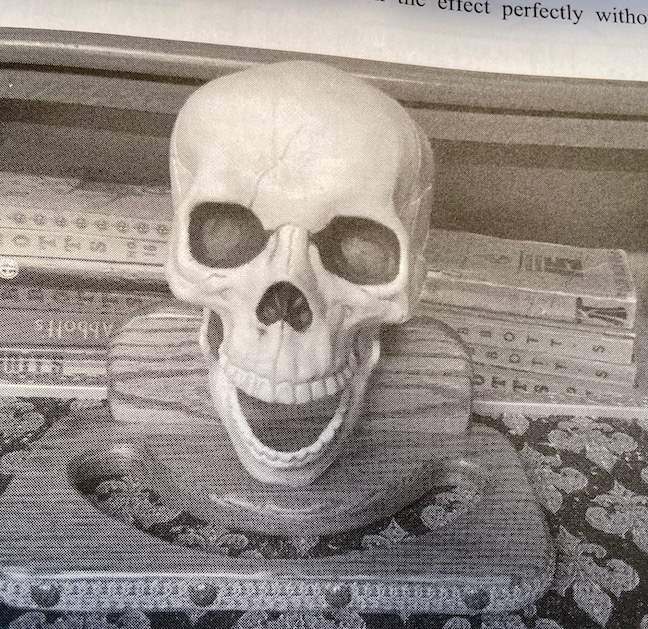
I thoroughly enjoyed David Seebach’s “Target: Midnight — The Blackout,” his eleven-page history of creating a full-scale ghost show for the stage, in 1991. As a youth I had fantasized about doing such a thing, but I see from David’s report how exhausting it must have been. Cheers to him for making his dark dream come true.
The final section, “Target: Midnight Keeping the Memory Today” reports on the current events of ghost show “entertainment, with such articles as “Keeping the Memory Flame Lit — Tidbits on Philip Morris by Amy Morris,” “Keeping the Memory Flame Lit — Potter Auctions,” and “Keeping the Memory Flame Lit — The Abbbott Magic Get Together.” (14 articles in 45 pages)
That last item refers to the very recent 2022 Get Together, at which this book appeared, at which Al the Only conducted the annual graveyard tour, and at which John Bundy performed his full evening ghost show. (So sorry I missed it!) Following this, a ghost show panel discussion was scheduled with David Seebach, Keith Stickley, and John Bundy. (I attended a Stickley ghost show in 2015, and it featured a truly scary blackout.) From all accounts, it was a fabulous Get Together.
Please don’t challenge my math; I counted only once. Instead, turn to the ad for the book on the Abbott web site, where all the article titles are listed. It is overwhelming! Altogether, this is a must have book for anyone intertested in ghost shows and seances.
Soft cover, 8.5 by 11 inches, 572 pages, $50 from Abbott’s Magic Company.
Best fun fact in the book? Neil Foster played a werewolf in John Calvert’s ghost show!

FISM KEEPSAKE — If you missed this year’s Abbott Get Together, you can at least experience a part of it by purchasing the ghost show book discussed above. Likewise, if you missed FISM a week earlier, you can experience part of it by purchasing Jim Steinmeyer’s lecture notes, a nicely produced booklet titled Brushstrokes Over Reality/ Understanding Magic as Art, Curating Magic as Performance. Jim devotes the first 13 pages to the age-old question, Is magic an art? Jim Steinmeyer is one of our most erudite, experienced magicians, and his thoughts reflect that. He poses seven considerations that qualify any endeavor as art, and he demonstrates those considerations with examples from classical painting and magic. If you like the question, you will love the answer.

Jim devotes the final 15 pages to six performance pieces (that is, magic tricks!). Some might chastise magicians for preferring tricks to philosophy in lectures, but in Jim Steinmeyer’s case I especially like the tricks. They are usually great. In this instance there is a silk transposition, three tricks involving cards plus other objects, a word divination involving cue cards, and a seance stunt involving five envelopes containing letters from a medium to her believers .This last item, The Vasty Deep, is the trick worth the price of the book, a sort of Bank Night in which four letters from a medium are dismissed by the spirits, and the final letter evidence of a psychic connection. The routine is both comical and spooky, and I look forward to performing it.
Softbound, 6 by 9 inches, 30 pages, beautifully laid out in full color, $27 plus postage from www.jimsteinmeyer.com.
Best adjective award? Referring to Nevil Maskelyne’s analysis of magic in Our Magic as stodgy.

